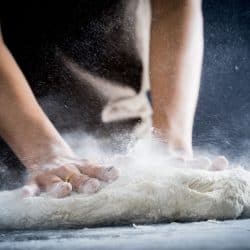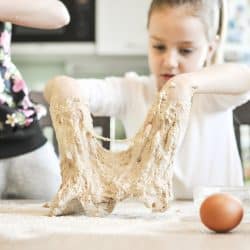It is important to know how long to knead pizza dough in a mixer. The amount of time differs between when you knead pizza dough by hand and when you use a mixer. We have researched all about how long to knead pizza dough in a KitchenAid mixer, and we have answers for you.
When you are using a KitchenAid mixer, it takes approximately 8-10 minutes to knead pizza dough. Be sure to use the dough hook.
If you would like to learn more about how to tell when pizza dough is kneaded enough, whether or not you can over-knead pizza dough, and what speed to use on your KitchenAid mixer, continue reading this post.
![pizza dough on wooden background. selective focus. - How Long To Knead Pizza Dough In KitchenAid Mixer? [& Other Dough Making Tips!]](https://kitchenseer.com/wp-content/uploads/2022/10/pizza-dough-on-wooden-background.-selective-focus.-How-Long-To-Knead-Pizza-Dough-In-KitchenAid-Mixer-Other-Dough-Makin.png)
How Do I Know If My Pizza Dough Is Kneaded Enough?
A lot of people have trouble getting their pizza dough to be the perfect consistency. Don't be too hard on yourself if you find yourself struggling with this.
There are a couple of indicators that pizza dough has been kneaded enough. One way to check is to stretch the dough. If it doesn't break, it is probably ready to be stretched out and prepared. On the other hand, if the pizza dough springs back immediately, this means the yeast is not done proofing.
Another way to tell if your pizza dough has been kneaded enough is by stretching it and shaping it and then holding it up. If it doesn't sag, your pizza dough is most likely ready for toppings.
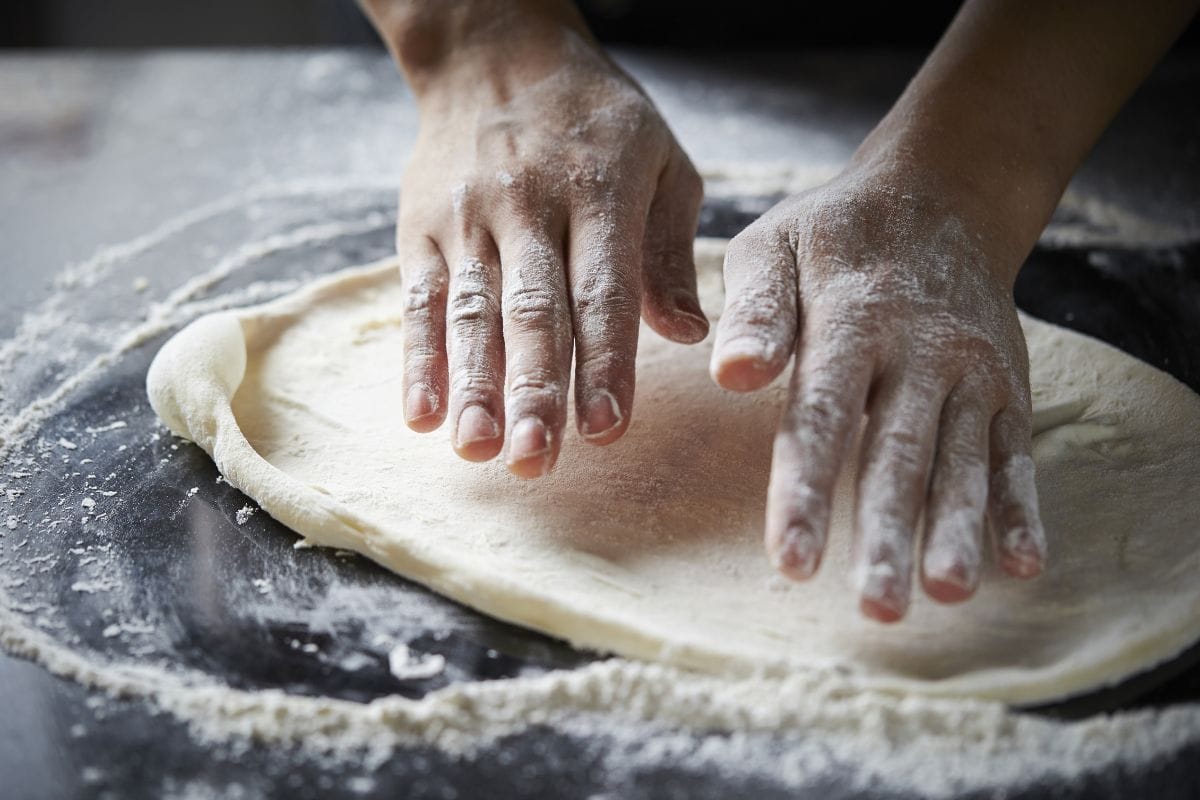
Make sure you use soft wheat flour when making pizza dough. People who have used flour high in protein for this have ended up with tough dough that is chewy and undesirable.
With that said, be mindful of the type of flour you use, the amount of time the dough is kneaded, and use accurate measurements for the liquid ingredients as well.
How Do You Tell If Your Dough Is Over-Kneaded?
You can actually look out for a few signs that your dough has been kneaded for too long. One way to tell is if the dough is resistant to being shaped. In this case, the yeast has died, and you likely need to start the process over.
Pizza dough that has been mixed too long gets overworked and can end up being stiff and hard. The ideal pizza dough is soft and pliable. It should be easy to stretch. If it isn't, something has gone wrong.
Can You Over-Knead Pizza Dough In Stand Mixer?
Yes, you can over-knead pizza dough. This will result in the dough tearing apart. What you want to end up with is a pizza dough that is stretchy and that springs back slowly after you pinch it.
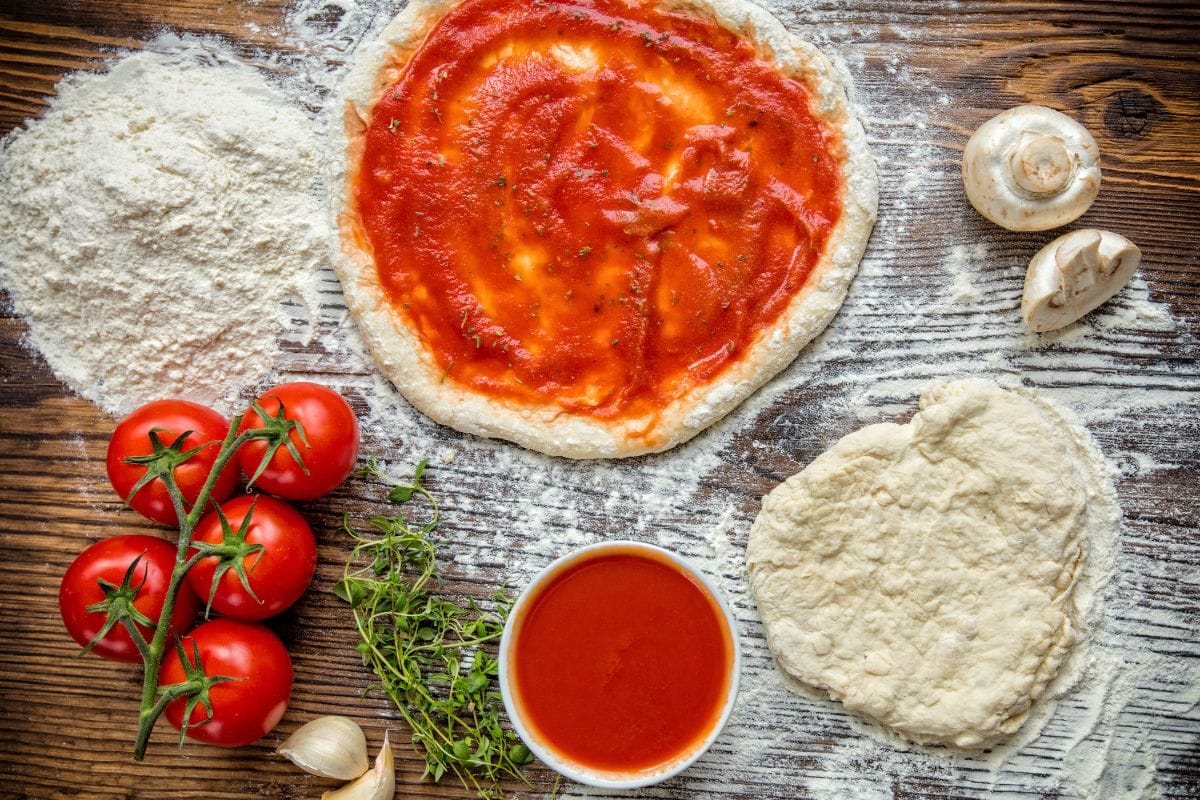
As long as you flour the surface well where you knead your dough, it will not stick as much. Avoid over-kneading pizza dough so that it does not become crumbly. If you knead pizza dough for too long you will end up with dough that isn't as good as it could be.
You can also under-knead dough. The pizza dough will be tough if you do not knead the dough for long enough. Kneading for the right amount of time is an important part of making pizza dough—or any dough for that matter.
What Speed Do I Use To Knead Dough In KitchenAid?
You should only use speed 2 whenever you are making any kind of dough or bread. Always use the dough hook when making dough.
The problem with kneading your dough too low is that it will mix slowly, and the dough will not knead the right way.
Yeast needs to be mixed at a faster speed so that it can proof. If you knead at a speed that is too high, such as higher than 2, the yeast will not proof correctly. It needs to be done at the right speed for the best results.
Should You Knead Pizza Dough After It Rises?
The reason for kneading dough is so that the gluten develops properly. You do this before it rises. You do not have to knead pizza dough after it rises, but you can. If you do decide to knead pizza dough after it rises, do so lightly. The bubbles will get demolished, which can result in dense, flat dough.
Ideally, you want to keep pizza dough bubbles intact because they help make the dough airy. Whenever you shape your pizza dough, do so gently to avoid destroying all of the bubbles.
Allow yeast to sit for 10 minutes before adding it to your flour mixture. It should be bubbly if the yeast is working correctly.
What Should The Texture Of Pizza Dough Be?
Ideally, the texture of pizza dough should be tacky but not extra sticky. The dough should be smooth. It should also be able to hold its shape without springing back too quickly or drooping.
After pizza dough has been baked, the texture should be chewy but not so much that it is difficult to chew. Pizza dough should also be airy and not tough. Add a little flour if your dough is too sticky. There are a few more tricks to learn about regarding making pizza dough.
Tips And Tricks For The Best Pizza Dough
Perhaps the most important tip we can give you for making the best pizza dough is to check the temperature of your warm water. Yeast will not react and proof if the temperature of the water is not right. It needs to be between 110 and 115 degrees Fahrenheit.
One important trick for making the best possible pizza dough is when you have pizza dough that feels tight, give the dough about 15 minutes to relax. This happens when you ball up the dough or refrigerate it. It is easier to stretch pizza dough after the gluten has had time to relax.
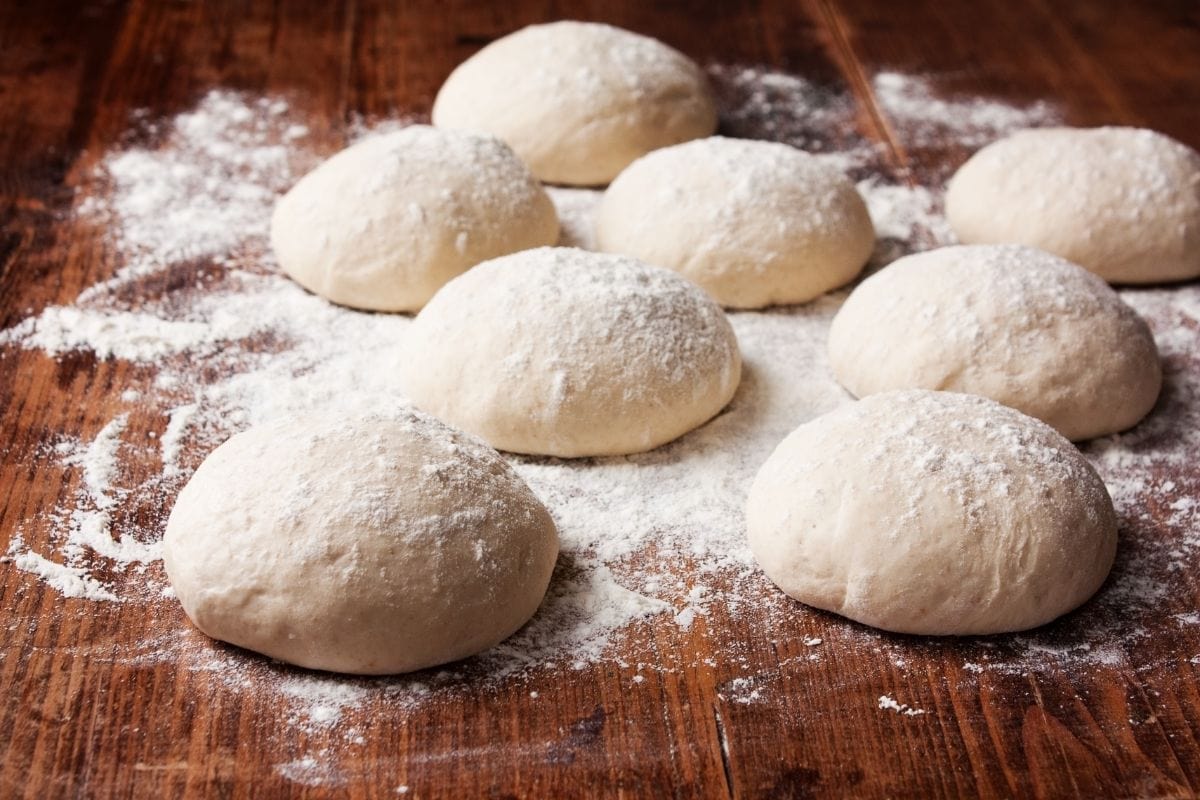
Another trick to making the perfect pizza dough is using the right flour for your personal preferences. If you prefer to have a crispy crust and chewy dough, bread flour is the right choice for you.
As for those of you who like a softer fluffier crust, use all-purpose flour. Always level off your flour to be sure you don't use too much.
Pay attention to what your pizza dough looks and feels like. It should be soft and stretchy. Make sure you allow the dough to warm up if it is cold. Pizza dough needs to be able to come to room temperature for the best results.
More Tricks For Making Pizza Dough
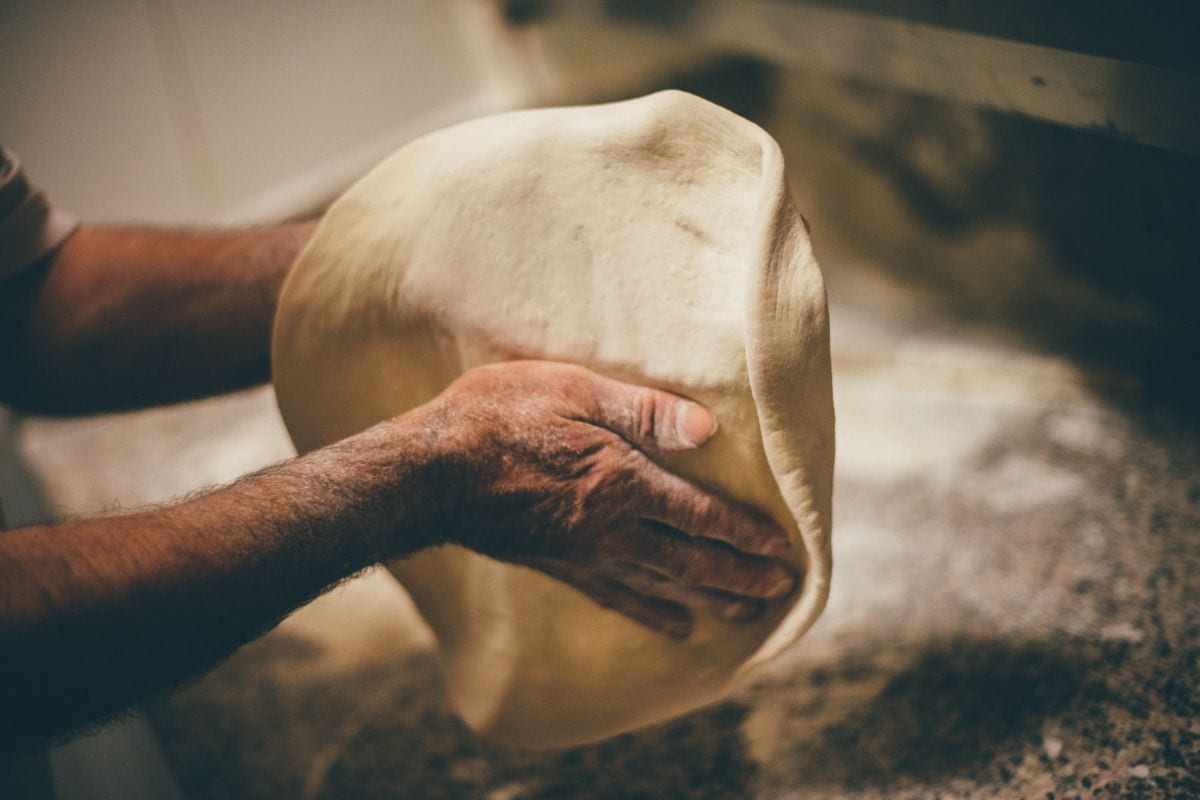
A trick to making the perfect dough is to use the right amount of water. If you do not use enough water, the dough will be dry. You won't be able to stretch your pizza dough if you do not use the correct ratio of flour and water.
One more tip for making pizza dough is not to use a rolling pin. Using a rolling pin does not cause the gluten to react the way it needs to.
Add seasonings to your pizza dough if you like a flavorful dough. Some examples that work great are Italian herbs, oregano, basil, and some people like to add rosemary to their dough. You can also add garlic powder, fresh garlic, or brush a garlic butter sauce onto your pizza dough before or after baking it.
If you add too much flour to your dough, you can add a little water at a time. A tablespoon at a time is the best way to go about getting the right ratio of flour and water. Use the correct measuring cups to help ensure your amounts are correct from the beginning.
Stretch your pizza dough evenly. Doing so will ensure that your dough cooks evenly and that you don't end up with one spot that isn't baked all the way through while the thinner crust is crispy. If you want the dough to be similar in thickness, stretch it evenly.
To Wrap It Up
With all things considered, you only need to knead pizza dough for 8-10 minutes when you are using a stand mixer such as a KitchenAid mixer.
Pizza dough should be stretchy without breaking; it should be soft and not too sticky. If your dough is hard or flat, something has gone wrong, and you likely need to start the process over again.
Before you go check out the following links all about pizza:
Pizza Dough Won’t Stretch – What To Do?
How Big Is A Pizza Box? [By Brand]
Can You Put An Egg On A Pizza? [Inc. Frozen Pizza]

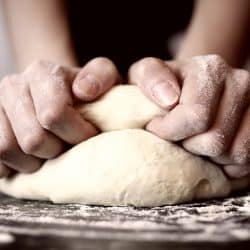
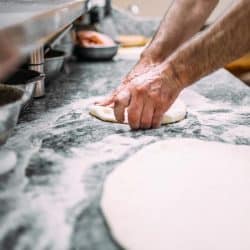
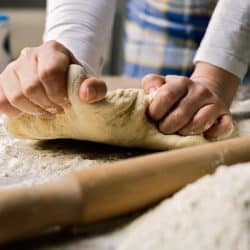
![Baker man hands breadmaking kneading bread dough, How Long To Knead Bread [By Hand And In A Mixer]](https://kitchenseer.com/wp-content/uploads/2021/03/Baker-man-hands-breadmaking-kneading-bread-dough-250x250.jpg)
